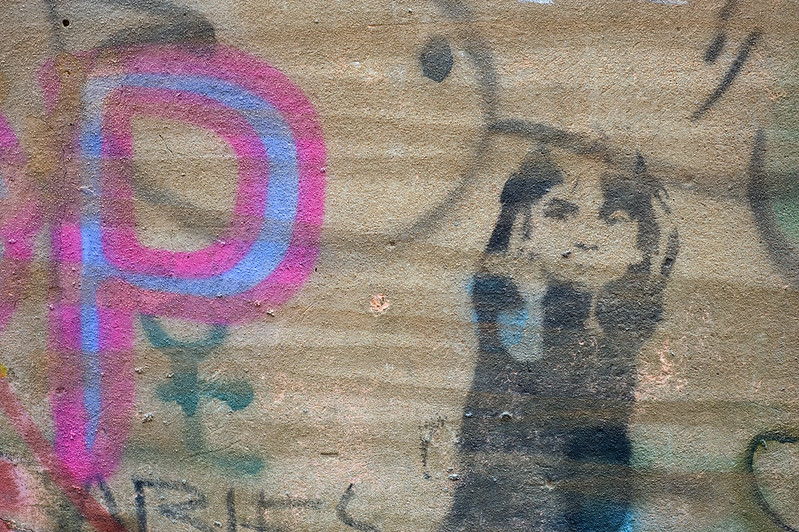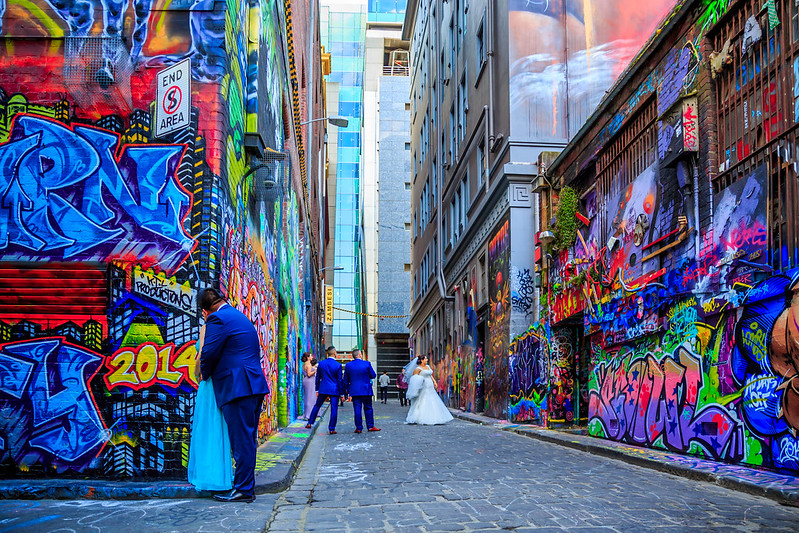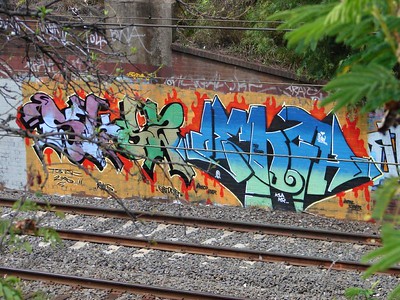Melbourne’s metro lines are wallpapered with a collage of tags, street art, names, and pictures— temporary snapshots of a moment in time. Every year, $10 million is invested to tackle graffiti and vandalism along the metro train network. Meanwhile, graffiti-coated city spots like Hosier Lane have become celebrated tourist must-sees, and have put the city on the map as the self-proclaimed “street art capital of the world”.
It’s a tug of war the city seems to be perpetually participating in.
The City of Melbourne draws the line between the two based on which has permission to exist. Graffiti is the illegal “marking” of private property, whereas street art is an “artistic work” that is endorsed, and even marketed by the city.
Adrian Doyle, who founded Melbourne Street Tours, the only street art tours group run exclusively by street artists, has been active in Melbourne’s street art scene for decades. He may come from a fine art background but he started his artistic life “scribbling on trains, playing in drains and exploring abandoned buildings”. He tells upstart that there is a notable cultural difference between the graffiti scene and the street art scene, even though the mediums are similar. The graffiti scene, he says, is one that is “subversive and isolated” from mainstream culture.
“If you’re not part of the culture and you don’t understand it, that’s on you, they don’t care,” he says. “So, if you can’t read the tags, stiff sh–.”

According to Doyle, while graffiti is influenced by the 1960s and 70s New York and Chicago art movement that brought it into the mainstream as a form of rebellious self-expression, street art is closer to fine art in that the artist considers all elements, from the building it’s placed on to the content itself.
Doyle started Blender Studios, an urban and fine art studio, 22 years ago when Melbourne’s street art scene in the city was very different. He remembers the unique and quirky art which could be found all over Melbourne. Much of it disappeared in 2006 due to the Commonwealth Games causing graffiti around the city to be cleaned up and the laws to change. Blender Studios remains a “research gallery for street artists”, and currently hosts over 24 resident artists. During the Zoom call, Doyle showed upstart a tour group of young people in the background, being led through the space filled with striking art and shelves of organised chaos.

At the same time social media has allowed more these forms of art to be widely shared beyond the streets they exist in. This, he says, led to Melbourne’s quirky styles becoming more homogenous. It also meant that money’s impact on street art grew and changed the community’s dynamic.
“Back when we started it was very much everyone working together to create a scenario where we were all a team … It wasn’t competitive,” he said. “Now that there’s become money and this and that it’s become even worse than the fine art world where everyone is fighting over the little bit of money.”
Situationist writer Raoul Vaneigem describes the process of radical ideas being absorbed into mass media culture as “recuperation”. It’s now not uncommon to see street art aesthetics used in advertising, shopping centres, and the side of businesses to make them less corporate and more urban.
Melbourne’s laneways are vital to the city’s culture, and tourism. A big part of Melbourne’s identity are the small brick or concrete lanes chock full of street art that Doyle has helped to set up. In 2022, Doyle estimated that Melbourne Street Art Tours attracted 40,000 visitors every year prior to the pandemic, and Hosier Lane alone attracts 80,000 people per year.

While talking to Doyle, a group was touring Blender Studios, one of many tours that are guided through the city’s iconic street art scene. Doyle has set up seven full laneways as street art attractions throughout the city, but finds that it leads to other people, often people from overseas, investing in that space and getting the benefits, instead of the community that’s always been there.
“Wherever we tend to set up a really cool laneway it gets gentrified, and someone wants to build skyscrapers next to it because it’s much more valuable,” he says.
This, in turns, leads to a loss of potential for more of these spaces.
“The more we gentrify the city the less canvas there is.”
The less legal form of street art and graffiti that spill out across Melbourne also form part of its identity, too. Tourists are guided along the metro lines into the city by appearances of renegade fixtures like ‘Pam’s bird’, a colourful design that can be found everywhere in the city, from major train stations to scrawled along tramlines. Likewise, for people willing to look, Melbourne’s banana peel tagger offers a scavenger hunt of sorts along everyday streets.
Melbourne’s negotiated relationship with street art culture is witnessed in its desperate, prohibitive efforts to match the tenacity of the illegal graffiti scene with its efforts to stem it. A New York subway-style “zero tolerance” approach to graffiti meant trains would be pulled from service for tagging even if it would cause delays. Operation Deep Clean tried to “break the cycle” by charging offenders. Now the city is trying drones to locate them. A Department of Transport and Planning spokesperson tells upstart $10 million is invested to stop vandalism every year and they’re still removing 3,000 and 4,000 square meters of graffiti each week.
“In 2022 we removed more than one MCG’s worth of graffiti every month on the metropolitan train network alone,” they said.

Despite all the changes in Melbourne street art, both the illegal, renegade art, and the more privileged, culturally sanctified forms persist. The street art scene may now exist in a more corporate environment, but Doyle doesn’t view that as an entirely bad thing, because it means he gets to make a living off his work. But he has also witnessed the loss of community from the old days.
“There is a benefit to the financial side of it but there’s a loss of purity, there’s a loss of what it was all about in the beginning,” he said. “It was very comrade driven.”
But through all the changes to the street art scene, Doyle knows graffiti will remain a constant in the life of the city.
“Whereas street art’s come and gone, graffiti will be here forever because young people like to make marks.”
Photo: Graffiti, Melbourne by Duncan Cumming found HERE and used under a Creative Commons (CC BY-NC 2.0) licence. The image has not been modified.







